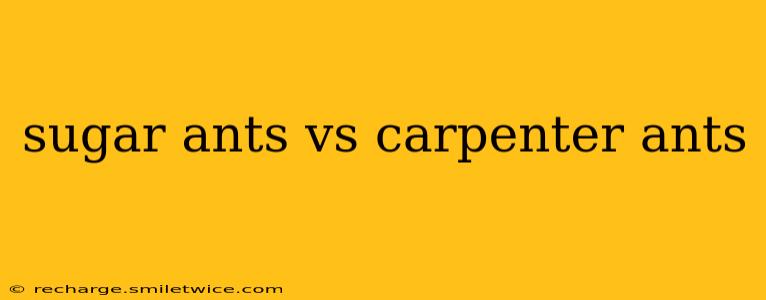Ants are a common household nuisance, but knowing which species you're dealing with is crucial for effective pest control. Two frequently encountered species are sugar ants and carpenter ants, each posing different challenges and requiring distinct approaches to eradication. This comprehensive guide will help you differentiate between sugar ants and carpenter ants, understand their behaviors, and implement effective control strategies.
What are Sugar Ants?
Sugar ants, often referred to as odorous house ants ( Tapinoma sessile), are small, dark brown or black ants that are attracted to sweet substances. Their name derives from the characteristic odor they emit when crushed – a slightly pungent, rotten coconut smell. They are omnivorous, meaning they consume a wide variety of foods, but their preference for sweets makes sugary spills and crumbs a major attractant. These ants are incredibly common and can infest homes quickly, forming large colonies.
Identifying Sugar Ants: Key Characteristics
- Size: 1/16 to 1/8 inch long.
- Color: Dark brown to black.
- Diet: Sweets, greasy foods, meats, and other organic matter.
- Odor: Distinctive, rotten coconut smell when crushed.
- Nest: Typically nest outdoors in soil, under rocks, or in decaying wood, but can also nest inside walls or crevices.
What are Carpenter Ants?
Carpenter ants (Camponotus species) are significantly larger than sugar ants and, unlike sugar ants that primarily feed on sweets, they are primarily scavengers. While they don't eat wood, they excavate it to create nests, causing structural damage to homes and other wooden structures. This is a key distinction that sets them apart from sugar ants. Several species of carpenter ants exist, varying slightly in size and appearance.
Identifying Carpenter Ants: Key Characteristics
- Size: 1/4 to 1/2 inch long (significantly larger than sugar ants).
- Color: Varies; common colors include black, red, or a combination of both (black and red).
- Diet: A wide variety of foods including insects, honeydew, and other sweets, but they do not feed on wood.
- Odor: Some species have a slight odor, but not as distinctive as sugar ants.
- Nest: Nest primarily in damp, decaying wood, both inside and outside of buildings. They often create extensive networks of tunnels and chambers.
Sugar Ants vs. Carpenter Ants: A Comparison Table
| Feature | Sugar Ants (Odorous House Ants) | Carpenter Ants |
|---|---|---|
| Size | 1/16 to 1/8 inch | 1/4 to 1/2 inch |
| Color | Dark brown to black | Black, red, or black and red |
| Diet | Sweets, greasy foods, meats | Insects, honeydew, other foods |
| Wood Damage | No | Yes |
| Odor | Strong, rotten coconut smell | Mild or no distinctive odor |
How to Get Rid of Sugar Ants
Controlling sugar ants involves eliminating food sources and creating an inhospitable environment. Thorough cleaning is paramount.
- Cleanliness: Regularly wipe down counters, sweep floors, and promptly clean up spills.
- Storage: Store food in airtight containers.
- Baiting: Sugar ant baits are effective; these contain slow-acting poison that ants carry back to the colony.
- Exclusion: Seal cracks and crevices to prevent ants from entering your home.
How to Get Rid of Carpenter Ants
Carpenter ant control requires a more targeted approach, often involving professional pest control services. Because of the structural damage they can cause, early detection and intervention are essential.
- Professional Help: Carpenter ants are often harder to eliminate than sugar ants, necessitating professional intervention.
- Locating the Nest: Identifying the nest is critical for effective treatment.
- Treatment: Professional pest control utilizes targeted treatments to eliminate the colony.
What are the best ways to prevent ants from getting into my house?
Preventing both sugar ants and carpenter ants from entering your home starts with preventative measures. These include:
- Seal Entry Points: Caulk cracks and crevices in walls, foundations, and windows.
- Remove Moisture: Fix leaky pipes and address any damp areas in your home.
- Proper Sanitation: Keep your kitchen and pantry clean and free of food crumbs.
- Yard Maintenance: Keep woodpiles away from your house and trim overhanging branches.
Are sugar ants dangerous?
Sugar ants are not typically considered dangerous. While they are a nuisance, they don't pose a significant health threat. They don't sting or bite humans, and they don't carry diseases.
Do carpenter ants bite?
Carpenter ants can bite, but their bites are generally not painful. However, their bite may cause a slight irritation. The greater concern with carpenter ants is the structural damage they inflict on wooden structures.
This guide provides a solid understanding of the differences between sugar ants and carpenter ants, allowing you to identify the species infesting your home and take appropriate action. Remember, professional pest control may be necessary for larger infestations or for carpenter ant control.
